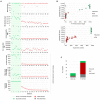Strengthening the genomic surveillance of Francisella tularensis by using culture-free whole-genome sequencing from biological samples
- PMID: 38249473
- PMCID: PMC10797068
- DOI: 10.3389/fmicb.2023.1277468
Strengthening the genomic surveillance of Francisella tularensis by using culture-free whole-genome sequencing from biological samples
Abstract
Introduction: Francisella tularensis is a highly infectious bacterium that causes the zoonotic disease tularemia. The development of genotyping methods, especially those based on whole-genome sequencing (WGS), has recently increased the knowledge on the epidemiology of this disease. However, due to the difficulties associated with the growth and isolation of this fastidious pathogen in culture, the availability of strains and subsequently WGS data is still limited.
Methods: To surpass these constraints, we aimed to implement a culture-free approach to capture and sequence F. tularensis genomes directly from complex samples. Biological samples obtained from 50 common voles and 13 Iberian hares collected in Spain were confirmed as positive for F. tularensis subsp. holarctica and subjected to a WGS target capture and enrichment protocol, using RNA oligonucleotide baits designed to cover F. tularensis genomic diversity.
Results: We obtained full genome sequences of F. tularensis from 13 animals (20.6%), two of which had mixed infections with distinct genotypes, and achieved a higher success rate when compared with culture-dependent WGS (only successful for two animals). The new genomes belonged to different clades commonly identified in Europe (B.49, B.51 and B.262) and subclades. Despite being phylogenetically closely related to other genomes from Spain, the detected clusters were often found in other countries. A comprehensive phylogenetic analysis, integrating 599 F. tularensis subsp. holarctica genomes, showed that most (sub)clades are found in both humans and animals and that closely related strains are found in different, and often geographically distant, countries.
Discussion: Overall, we show that the implemented culture-free WGS methodology yields timely, complete and high-quality genomic data of F. tularensis, being a highly valuable approach to promote and potentiate the genomic surveillance of F. tularensis and ultimately increase the knowledge on the genomics, ecology and epidemiology of this highly infectious pathogen.
Keywords: Francisella tularensis; Microtus arvalis; RNA oligonucleotide baits; SureSelect; WGS.
Copyright © 2024 Isidro, Escudero, Luque-Larena, Pinto, Borges, González-Martín-Niño, Duarte, Vieira, Mougeot, Vidal, Herrera-Rodríguez, Rodríguez-Pastor, Herrero-Cófreces, Jubete-Tazo, Gomes and Lopes de Carvalho.
Conflict of interest statement
The authors declare that the research was conducted in the absence of any commercial or financial relationships that could be construed as a potential conflict of interest.
Figures


Similar articles
-
Phylogeography and Genetic Diversity of Francisella tularensis subsp. holarctica in France (1947-2018).Front Microbiol. 2020 Mar 4;11:287. doi: 10.3389/fmicb.2020.00287. eCollection 2020. Front Microbiol. 2020. PMID: 32194525 Free PMC article.
-
Francisella tularensis Subspecies holarctica and Tularemia in Germany.Microorganisms. 2020 Sep 22;8(9):1448. doi: 10.3390/microorganisms8091448. Microorganisms. 2020. PMID: 32971773 Free PMC article. Review.
-
Revisiting Francisella tularensis subsp. holarctica, Causative Agent of Tularemia in Germany With Bioinformatics: New Insights in Genome Structure, DNA Methylation and Comparative Phylogenetic Analysis.Front Microbiol. 2018 Mar 13;9:344. doi: 10.3389/fmicb.2018.00344. eCollection 2018. Front Microbiol. 2018. PMID: 29593661 Free PMC article.
-
Genetic Diversity and Spatial Segregation of Francisella tularensis Subspecies holarctica in Germany.Front Cell Infect Microbiol. 2019 Nov 6;9:376. doi: 10.3389/fcimb.2019.00376. eCollection 2019. Front Cell Infect Microbiol. 2019. PMID: 31781515 Free PMC article.
-
Genotyping of Francisella tularensis, the causative agent of tularemia.J AOAC Int. 2010 Nov-Dec;93(6):1930-43. J AOAC Int. 2010. PMID: 21313823 Review.
Cited by
-
Evaluating methods for genome sequencing of Chlamydia trachomatis and other sexually transmitted bacteria directly from clinical swabs.Microb Genom. 2025 Feb;11(2):001353. doi: 10.1099/mgen.0.001353. Microb Genom. 2025. PMID: 39943872 Free PMC article.
References
-
- Aloni-Grinstein R., Schuster O., Yitzhaki S., Aftalion M., Maoz S., Steinberger-Levy I., et al. (2017). Isolation of Francisella tularensis and Yersinia pestis from blood cultures by plasma purification and Immunomagnetic separation accelerates antibiotic susceptibility determination. Front. Microbiol. 8:312. doi: 10.3389/fmicb.2017.00312, PMID: - DOI - PMC - PubMed
LinkOut - more resources
Full Text Sources

